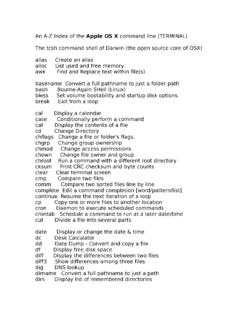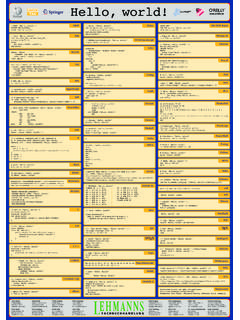Transcription of PART I - Discovering Systems - Passive Footprinting
1 Enterprise Intrusion Analysis UUASC November 2005 PART I - Discovering Systems - Passive FootprintingPassive Footprinting is a method in which the attacker never makes contact with the targetsystems. The downside to the active method for an attacker is that many companies may logcontact between an attacker and the target system . Since ICMP traffic is so common, attemptingto log all ping requests would be cumbersome, so ICMP pings are often not recorded. This is notthe case for TCP connections and/or DNS following sections describe Passive fingerprinting techniques used by attackers to discoversystems on a Registrar QueriesAll domains are registered through a domain registrars.
2 Information about the domain in questioncan be accessed publically through the whois utility. Information such as contact information,email addresses, and DNS Authoratative servers can be discovered in these are many domain registrars available. The first step an attacker must take is to discoverwho the registrar is for a specific domain. This can be accomplished using the freely availableonline whois utility available at Once an attacker knows the domain registrar for a specific domain, the whois utility can be usedto locate information about that domain. In the following example, the attacker has discoveredthat is the domain registrar for the domain The whoisutility is used to extract the registration information for that domain.
3 # whois -h [Querying ][ ]Domain Creation 2002-04-02 Registration 2002-04-02 Expiry 2006-04-02 Organisation Resident Unix Geek Organisation Address. 12345 Test Drive Organisation Address. Organisation Address. Manhattan Beach Organisation Address. 90266 Organisation Address. CA Organisation Address. UNITED STATESA dmin Darren Hoch Admin 6789 Unix Way Admin Admin Manhattan Beach Admin 90266 Admin CA Admin UNITED STATES 2005 Darren Hoch webmaster [at] litemail [dot] org1 Enterprise Intrusion Analysis UUASC November 2005 Admin Admin (888) 867-5309 Admin Tech Generic Hostmaster Tech 5050 Haxor Lake Dr.
4 Tech Tech Boca Raton Tech 33431 Tech FL Tech UNITED STATES Tech Tech 888-663-6648 Tech Name Name available automated tools exist that automate the process of querying domain dmitry (Deepmagic Information Gathering Tool) tool by James Greig is a command line toolthat passively gathers domain registrar information, as well as other public information from websearches (Google) and online statistics sites (Netcraft) about the target Systems and creates a logof all information following example demonstrates how an attacker would use dmitry to discover informationabout the domain #.
5 /dmitry -iwns -o # more <<output ommitted for brevity>>Gathered Inic-whois information for On:23-Aug-2002 21:19:49 UTCLast Updated On:24-Aug-2005 01:43:59 UTCE xpiration Date:23-Aug-2006 21:19:54 UTCS ponsoring Registrar:GENERIC WEBHOST Worldwide (RXX-LXXX)Status:OK<<output ommitted for brevity>>Gathered Netcraft information for (Fedora) Currently No Uptime reports availableGathered Subdomain Search information for Search Engine Queries 2005 Darren Hoch webmaster [at] litemail [dot] org2 Enterprise Intrusion Analysis UUASC November 2005 The Google search engine is the most widely used search engine on the earth.
6 Most searchesconducted on Google are nothing more than strings of keywords. Many end users are unaware ofits very extensible search string syntax and a programming API available to do automated andcommand line searches. An attacker can leverage these features to do Passive fingerprinting on a single system or anentire domain by creating very complex search strings using Google's "Advanced Operators".These operators are often typed into the Google search bar from the main Google site. The following is a list of the most common advanced operators: intitle:keyword - The query returns pages with the keyword in the HTML title tag<title>keyword</title> inurl:keyword - The query returns pages with the keyword in the url string site.
7 Url - The query returns only pages from the site +keyword - This operator forces the inclusion of the word that follows it -keyword - This operator forces the exclusion of the word that follows itThe following Google search string matches all sites that have the domain in themexcluding the site, + a combination of command line tools such as lynx, awk, sed, sort, and DNS, an attackercan write scripts that leverage Google queries to identify a list of target Systems in a company'sdomain. The following script, ( ), enables an attacker tofind all unique domain names in the domain and obtain IP addresses for those domainnames through DNS.
8 # cat cat #!/bin/shif [ -f / ]then rm -rf / "Google DNS Passive Fingerprinter "echo "-------------------------------------"e choecho -n "Enter base domain, exluding www [ ]: "read SITE echo -n "How many pages would you like to search?: "read NUMecho 2005 Darren Hoch webmaster [at] litemail [dot] org3 Enterprise Intrusion Analysis UUASC November 2005echo "Finding subdomains for the site $SITE"lynx -dump " :$SITE+-www.$SITE&num=$NUM"| sed -n 's/\. http:\/\/[[:alpha:]]*. \//& /p' | awk '{print $2}' |sed 's/http:\/\///' | sed -s 's/\///' | sort -u > / each in $(cat / )do host $eachsleep 1done#.
9 Google DNS Passive Fingerprinter base domain, exluding www [ ]: many pages would you like to search?: 50 Finding subdomains for the site has address has address has address has address <<output ommitted for brevity>>Google provides a complete API to do more advanced automated queries. A license agreementand user account must be created in order to generate a key and download the API kit. Thefollowing Google API query tools are freely available on the Internet. - Written by Roelof Temmingh ( ), this script uses a combinationof advanced operators and logic to find subdomains BiLE and BiLE-Weight - Bi-directional Link Extractor ( ) are a set of scriptsthat locates links to and from sites and weigh their relevance to each other, placing the most relevantlinked site first.
10 2005 Darren Hoch webmaster [at] litemail [dot] org4 Enterprise Intrusion Analysis UUASC November 2005 Part II - Enumerating Remote ServicesAfter a target system has been detected, the attacker will attempt to discover all of the servicesrunning on the system . Each service that is accessible over the network represents a possibleback door through a remote exploit. Often refered to as "host enumeration", the process ofservices discovery yeilds the following information required for attack. The remote operating system All running services Unpatched or vulnerable servicesBanner EnumerationMany remote services either display text banners when connecting to the service or allow theservice version to be queried.



